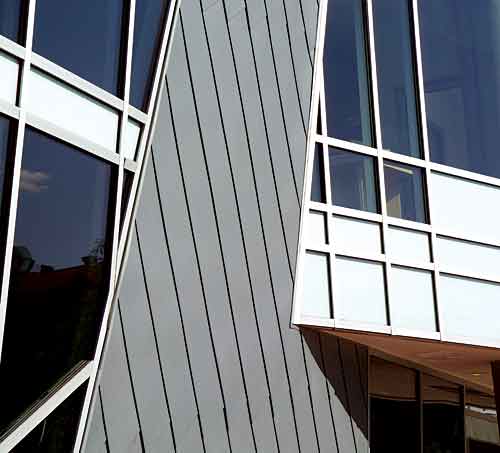Architectural Zinc: From Gray to Green
Physical Protection
Zinc's elemental protective properties show themselves in almost all its applications, from its use in human health to nutrition for soil, agricultural crops and animals. Zinc coatings protect steel in the construction industry. Being a "sacrificial" metal, zinc will "sacrifice" itself to protect the steel, preventing corrosion and lengthening steel's life by at least a factor of five. However, as a building material, solid architectural-grade zinc is even more effective.
A distinction must be made between solid and coated metals. Coatings come in many forms, including galvanizing, lead-coating, terne-coating and painting. Coated metals require additional energy to have the coating applied, and some surface treatments use toxic ingredients.
|
But with solid zinc, no paint, varnish or sealants, or maintenance of any kind, are required. When a treated surface is scratched, the coating is gone. Of all the forms of coating, certainly none are self-healing after the coating has been scratched away. Regardless of the coating or its method of application, its durability is limited. Whether it has been scratched off or it has faded away, no coating will last as long as its base metal. Eventually it will break down, requiring maintenance. In contrast, a roof or wall of solid zinc alloy is self-healing and self-maintaining.
The key to the extraordinary durability of zinc roofs and facades, and often cited as the source of their beauty over time, is patination. Just as copper ages from orange to green, zinc over time develops its distinctive patina, going from shiny silver to matte bluish gray (depending on the precise alloy, other colors and finishes are also possible). In contact with the water, oxygen and carbon dioxide molecules in the atmosphere, the surface forms a closely adhering protective layer of zinc carbonate, which is insoluble in rainwater and will hinder any further exchanges between oxygen and zinc, thereby protecting the zinc from further corrosion. Zinc continues to renew this protective layer throughout its life, although the heaviest formation is usually complete in about five years, and will self-repair any imperfections or scratches.
Zinc and More Than Zinc
In its pure form elemental zinc is too soft and brittle for architectural applications. Architectural-grade zinc is an alloy providing both the malleability and strength for architectural profiling. Precise alloy formulas are proprietary and highly engineered, but they typically consist of purified zinc-99.995 percent pure-plus very small amounts of titanium, which improves tensile strength and hardness and reduces the coefficient of expansion, as well as copper, which improves workability.
|
Since the purity and quality of the zinc alloys is so important to their performance, exacting independent certification criteria have been established. The TÃœV Quality Zinc certification awards a label to products that meet strict testing criteria, particularly for mechanical and technological properties and chemical composition. International standards also exist for zinc manufacturing (see "Zinc Standards" in the online section of this article).











